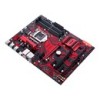Asus EX-B250-V7 User Guide - Page 12
Rear panel connectors, USB 2.0 ports USBGuard support., USB 3.0 ports - bios update
 |
View all Asus EX-B250-V7 manuals
Add to My Manuals
Save this manual to your list of manuals |
Page 12 highlights
Front panel audio connector (10-1 pin AAFP) This connector is for a chassis-mounted front panel audio I/O module that supports either HD Audio or legacy AC`97 audio standard. Connect one end of the front panel audio I/O module cable to this connector. • We recommend that you connect a high-definition front panel audio module to this connector to avail of the motherboard's high-definition audio capability. • If you want to connect a high-definition front panel audio module to this connector, set the Front Panel Type item in the BIOS setup to [HD Audio]. If you want to connect an AC'97 front panel audio module to this connector, set the item to [AC97]. By default, this connector is set to [HD Audio]. PCI Express 3.0/2.0 x16 slots This motherboard has three PCI Express 3.0/2.0 x16 slots that support PCI Express 3.0/2.0 x16 graphic cards complying with the PCI Express specifications. PCI Express 3.0/2.0 x1 slots This motherboard supports PCI Express x1 network cards, SCSI cards, and other cards that comply with the PCI Express specifications. Rear panel connectors 1 2 3 45 67 10 1 98 1. USB 2.0 ports (USBGuard support). These 4-pin Universal Serial Bus (USB) ports are for USB 2.0/1.1 devices. 2. USB 3.0 ports. These 9-pin Universal Serial Bus (USB) ports are for USB 3.0/2.0 devices. • USB 3.0 devices can only be used for data storage. • We strongly recommend that you connect USB 3.0 devices to USB 3.0 ports for faster and better performance from your USB 3.0 devices. • Due to the design of the Intel® 200 series chipset, all USB devices connected to the USB 2.0 and USB 3.0 ports are controlled by the xHCI controller. Some legacy USB devices must update their firmware for better compatibility. 1-4 Chapter 1: Product introduction















